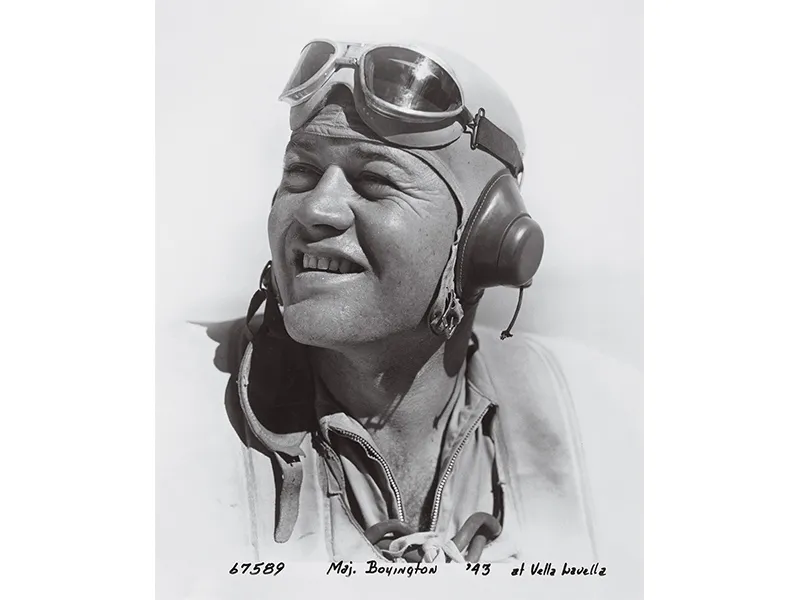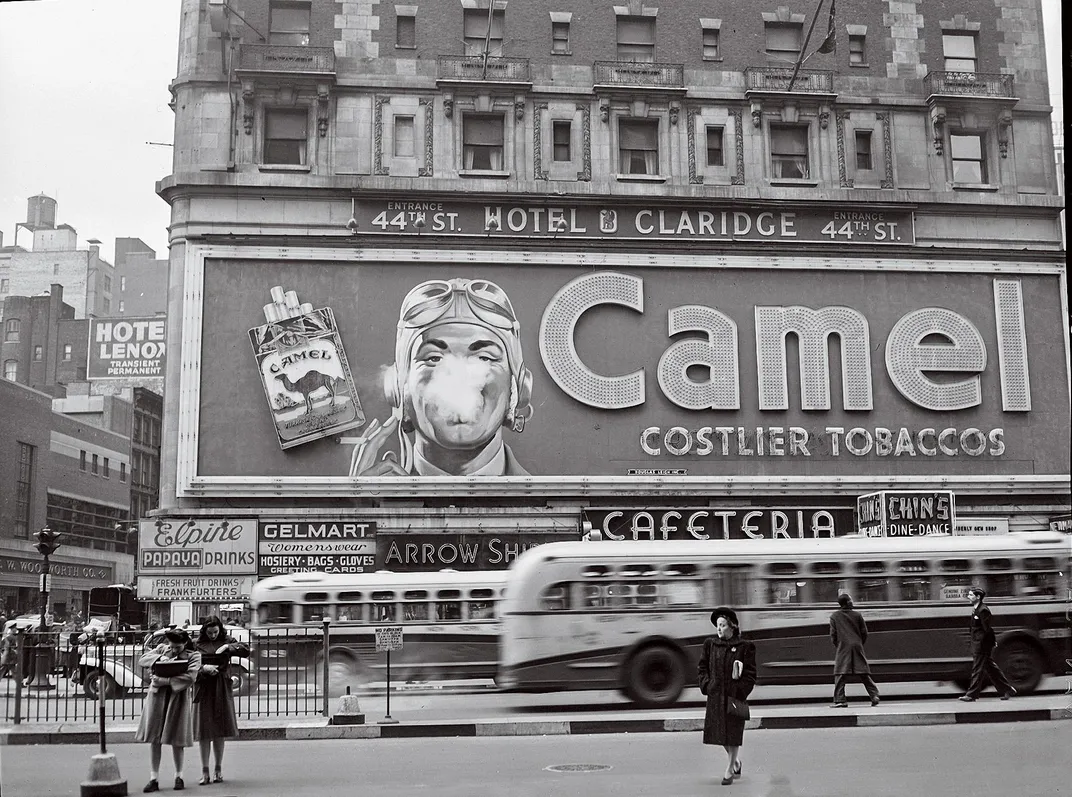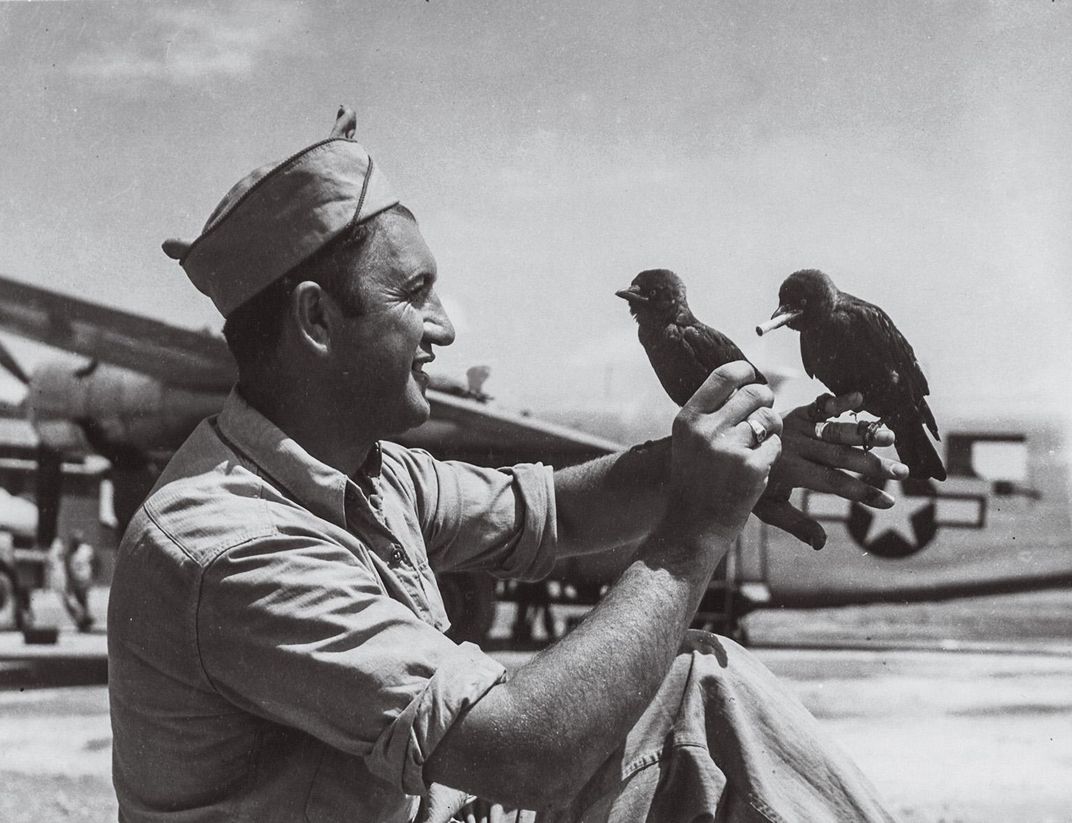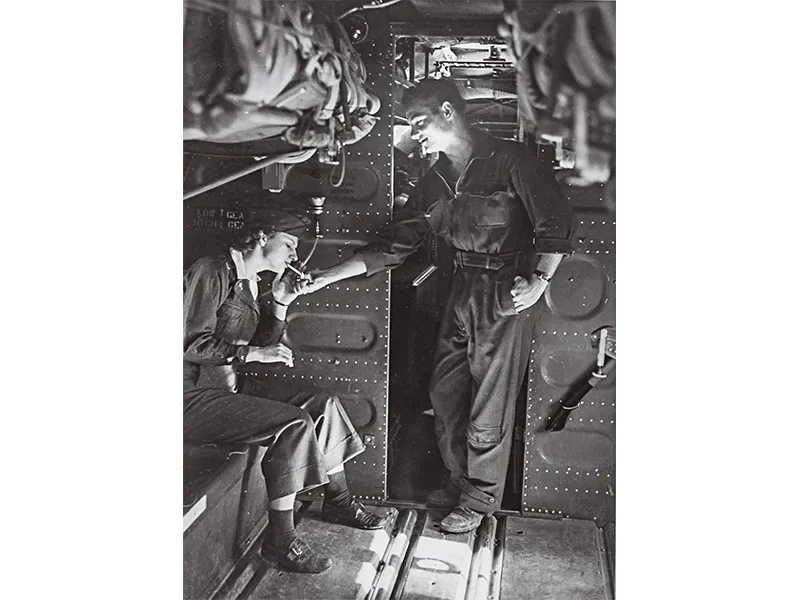Aboard World War II Airplanes, It Was Strictly Smoking Allowed
Marlboro Country reached all the way up to 40,000 feet.
/https://tf-cmsv2-smithsonianmag-media.s3.amazonaws.com/filer/5c/5a/5c5af263-a2e1-4f7d-8f8c-302cf060833b/06-2c_as2021_b26replacesfpo06-2c_live.jpg)
As a flight of Marine Corsairs cruised over the Pacific, Lieutenant Robert McClurg watched the canopy of his leader’s aircraft intently. Gregory “Pappy” Boyington had his seat cranked all the way down and he was chain-smoking as usual.
Pilots were not supposed to smoke cigarettes in their fighters. It was a clear fire hazard. After all, a warplane was a flimsy aluminum shell wrapped around a conglomeration of stuff that naturally wanted to burn or explode—fuel, hydraulic fluid, oil, oxygen, weaponry. Adding a lit cigarette to that mix was perilous.
But Boyington wasn’t exactly a “by-the-book” type of guy. On the ground, he was a heavy drinker and, as he described in his autobiography, “an incessant smoker.” While on the job, hunting Japanese aircraft, one thing Boyington did not leave behind was his cigarettes.
As McClurg related in Boyington’s 1958 book Baa Baa Black Sheep, “I always know when we’re going into combat.” Keenly observing his leader, he looked for a break in the chain. When Boyington straightened up, cracked his canopy, and flicked his half-smoked Camel into the ocean, it was a sure sign that things were about to happen.

“Nearly everyone smoked in those days,” Army aviator Lieutenant James Alter wrote in his 2011 book, From Campus to Combat, “and considering the kind of work we were doing, no one would have been too worried about lung cancer even if we had known about it. What we did know was that Chesterfields satisfied; we’d walk a mile for a Camel; and just like us, Lucky Strike Green had gone to war.”
America supplied cigarettes to military men in stunning numbers during World War II. Philip Morris and other U.S. tobacco suppliers reported rolling and selling 290 billion smokes in 1943. In order to relieve boredom and improve the morale of fighting men, cigarettes came standard inside K-ration boxes along with candy and gum. If young soldiers and sailors wanted more, cigarettes were just 50 cents a carton or a nickel a pack. As a result, tobacco consumption skyrocketed during the war.
In the early 1940s, even the president smoked, as did glamorous movie stars like Humphrey Bogart and Lauren Bacall. And young men who dreamed of fighting in the skies looked up to Eddie Rickenbacker. America’s top World War I ace had been puffing on cigarettes since age five.
Smoking, in fact, could even help a prospective flier get accepted into the service. “When I went in for the physical exam, my blood pressure was too low,” Calvin Sanders told an interviewer in 2003. “They would not accept me. They took my three buddies, which, of course, disappointed me terrible.” The doctor told him, “ ‘Go out and smoke a cigarette,’ which I did, and it raised my blood pressure. And he says, ‘You’re okay.’ And they let me in.” Sanders later became a B-17 navigator, flying combat missions over Germany.
We can imagine the briefing and carrier ready rooms from Bassingbourn to Tarawa were almost constantly filled with a stifling wall of blue cigarette smoke, but many of these fliers didn’t snuff out their last cigarette and then take off—they continued smoking inside their aircraft.

Echoing the themes of mortality and fate illustrated in the first chapters of The Right Stuff, pilot Lance Teillon wrote online in 2011, “[Smoking is] obviously not beneficial, nevertheless a good number of us did smoke. I remember, during my annual physical one year, asking the doctor if he was going to lecture me on stopping smoking.” Then Teillon told the doctor he flew carrier fighters: “He looked at me and said, ‘Don’t bother stopping.’ ”
Warplanes took life violently and suddenly, while cigarettes took decades to do their work. Navy standout and Medal of Honor recipient Edward “Butch” O’Hare was a loyal Camel smoker. He died when his Hellcat disappeared near the Gilbert Islands before his 30th birthday.
Neel Kearby, another Medal of Honor aviator, was dead by 32. One novice aviator recalled mock dogfighting with the famous ace before Kearby was lost in combat. Frantically doing everything he could to shake this aerial virtuoso, the young man turned in his seat to witness a final indignity. As Kearby’s aircraft closed in on his tail, the pilot was casually lighting his smoke behind the gunsight.
Considering the odds, smoking was an insignificant risk. In his book, Fighter Pilot, U.S. Army Air Forces ace Robin Olds described wanting to smoke to calm down after avoiding a more immediate death. In a tussle with a Bf 109, Olds nearly plunged his P-38 straight into the ground. The high-speed pullout had torn out the left canopy panel. “My hands shook as I tried to light a cigarette as I flew on toward England,” he wrote. “No way, not with the wind. Damn, I was [expletive] freezing!”
Many of the giants in military aviation in the 1940s smoked. Marine ace Joe Foss flew with a cigar, though often unlit. Claire Lee Chennault was a chain-smoker, burning through two or more packs of Camels each day. And General Curtis LeMay, after 1944, was hardly ever seen without his trademark stogie.
/https://tf-cmsv2-smithsonianmag-media.s3.amazonaws.com/filer/88/02/8802858b-1ab2-4caf-8ec5-1ef93954e11b/chesterfield.jpg)
Lieutenant Colonel Olin Gilbert, the leader of the 78th Fighter Group, was racing for home through the clouds at 1,000 feet after a mission. Thinking he was safe, he loosened his seat straps, reached for a smoke, and lit it. Just then, a battery of radar-guided flak found his airplane, jolting him with terrifying blasts. “I never did find that cigarette,” Gilbert said later.
Chuck Yeager was a non-smoker and, it is worth noting, lived to age 97. In a 2013 question-and-answer session on Facebook, he revealed a possible reason why he didn’t smoke: “My flight leader insisted on smoking a pipe on return [from a mission]. He’d have to fly low to light it. One time flying low...he got shot down.”
A lot of fliers were sensible enough to abstain from smoking while breathing oxygen. However, there were many exceptions. In an oral history collection published by the Smithsonian Institution Press in 1993, top Navy ace David McCampbell described waiting out a group of Japanese bombers while flying at high altitude. Killing time, he elevated his smoking game: “I have been questioned about smoking a cigarette at 18,000 feet,” he said. “You can do it, because both my wingman and I did! It’s quite simple. You just pull the oxygen mask away from your face, put in a cigarette, and light it. You get the cigarette lit, put your mask back on, and periodically pull the mask away, take a puff on the cigarette, and then put your mask back on. You do this until you finish your cigarette, then throw the cigarette butt out the window. You crack the cockpit hood a little so the smoke will go out too.”
An Eighth Air Force B-24 pilot named Warren Blower adds some more detail to the high-altitude technique: “You could take a breath of oxygen and then take the mask away and take a drag on the cigarette and take another drag of oxygen. But you could smoke a cigarette for half an hour and it practically didn’t burn at all, the oxygen was so thin in the air. But when you got tired of smoking and you didn’t want to smoke anymore, [you could] take a deep breath of oxygen and blow through the cigarette and make the flame this long.”
/https://tf-cmsv2-smithsonianmag-media.s3.amazonaws.com/filer/d4/3d/d43d36bf-a943-42bb-a5a9-cf3eae6bb7fa/06-2d_as2021_menofthe12thbombgroup_live.jpg)
For better or worse, most fiercely independent fighter pilots agreed that bomber crewmen are simply a different breed. (And for bomber crews, the feeling was mutual.) As far as fighter jocks were concerned, multi-engine bomber men audaciously treated their aircraft like expansive flying smoking lounges.
Some aircraft manuals, in fact, assumed bomber crews would smoke and set up ground rules. Under the subsection “Smoking,” Consolidated’s B-24 Pilot Training Manual says: “A. No smoking in the airplane at an altitude of less than 1,000 feet. B. No smoking during fuel transfer. C. Never carry a lighted cigarette through bomb bays. D. Never attempt to throw a lighted cigarette from the airplane. Put it out first.”
“Lark Morgan, our tail gunner, smoked with his oxygen mask on,” recalled gunner Bud Guillot on a B-24 website. “He would move the mask to one side of his face and stick a cigarette in the corner of his mouth and then pull a little of the mask over the lip holding the cigarette. One could easily judge the ferocity of each mission by the number of cigarette butts on the floor of Morgan’s tail turret.”
At some stations in the aircraft, crewmen didn’t even have to use the floor. Manufacturers, anticipating long-duration flights, equipped many multi-crew aircraft of the era with ashtrays. Rather than spending time creating their own designs, they often acquired overstocked 1930s samples of “ash receptors” from automobile companies.
The forward section of Flak-Bait (the Martin B-26B Marauder that was on display at the National Air and Space Museum for decades, and is undergoing restoration and will be again displayed at the Museum in 2022) is equipped with 1939 Dodge pickup truck ashtrays. An observer could clearly see one installed next to the radio operator’s desk. But not every cigarette butt made it to its proper place. As Museum staffers cleaned the aircraft for display, they found numerous discarded smokes, along with gum wrappers, chaff fragments, machine gun shells, and bomb fuse tags, sifted into the belly of the bomber.

Many Vega and Consolidated aircraft flew with aftermarket surface-mounted dome “ash receptors.” Boeing somehow finagled a huge supply of 1935-1936 Ford passenger car ashtrays, which appeared in the cockpits of thousands of B-17s, B-29s, B-47s, and beyond.
In the big bombers, the smoking light wasn’t always on. Warren Blower discussed a hair-raising event when two of the three sides of the classic “fire triangle”—heat, fuel, and oxygen—were added to the belly of his B-24. An open flame would have led to disaster. “There was a fuel transfer pump right on the catwalk in bomb bays. And this thing apparently blew its seal and was spraying gasoline all over. And so we were just in the process of opening the bomb doors and getting it ventilated out when one of the oxygen lines goes. So we were full of gasoline and oxygen for a little while. We put the landing gear down so we could get some air through the nose [and] let it breathe out. When we were pretty well settled down again, I got on the intercom and I says, ‘I don’t suppose I have to tell anybody not to smoke.’ ”
From time to time, American warplanes inexplicably detonated in a ball of flame and very few lived to discuss the cause. A devastating blast sparked by a lighter or cigarette is still one of the leading theories to explain the fate of the Martin Mariner flying boat sent to search for Flight 19 over the Bermuda Triangle in 1945.
Then there is this tantalizing tidbit from the Bureau of Aircraft Accidents Archives, relating the fate of a C-47 over Burma that same year. The “causes” write-up explains: “The captain was lighting a cigarette while holding his oxygen tube. The Zippo lighter flame caused the gasoline in the lighter to explode. The fireball set the C-47 on fire. All 3 crew members bailed out successfully over the Hukawng Valley.”

Some aviators fought like hell to keep smokers off their flights. In a 2013 Library of Congress oral history, cargo pilot Donald Krambeck related his pre-flight announcement in the China-Burma-India Theater. As their fuel-loaded Liberator lined up at the end of the runway, he said, “Now, we’ve got to have a minute and a half for our prayer, and nobody smokes on this airplane because the fumes just surround you and, kaboom, you’re gone.”
Cruising toward some remote base in China, Krambeck continued the story: “We had barrels that we had used and used and they all leaked. 100 octane gas was on the floor, and I told the co-pilot, ‘Hold the course. I’m going back and figure out who’s smoking.’ This guy was crouched down behind a 55-gallon barrel smoking a cigarette and I said, ‘Do you want to die? Do you want me to die? Do you want the co-pilot to die? And do you want to lose this airplane?’ He was just shaking. I said, ‘Well, don’t put that out in the gas.’ So he put it out in the palm of his hand.”
Not everyone had that degree of vigilance. In an oral history, radarman Anthony Adams related a wheels-up landing in a B-29 at Saipan. “Well, all right,” he said when they crunched to a stop, spilling out the last of their fuel over the runway. “It wasn’t that bad. We all got out of the airplane and everybody lit up cigarettes like idiots.”